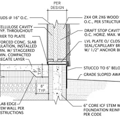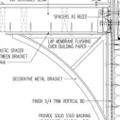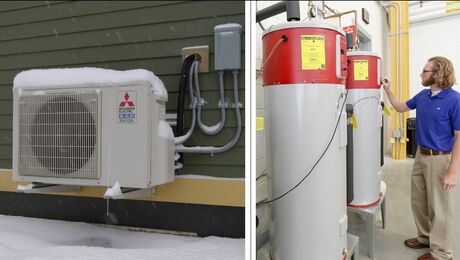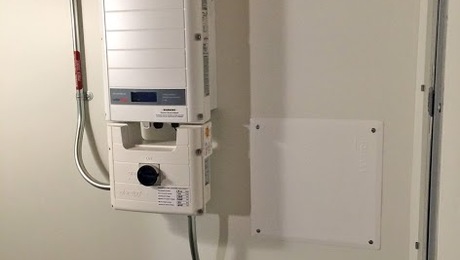Air intake for ERV
Asking again about an ERV installed incorrectly during a renovation before I bought this house. Currently, the ERV connects to the air handler, but both the air intake and exhaust are located inside the attic.
I have exhausted all the local HVAC companies claiming ERV/HRV expertise. One company claimed an intake inside the attic was fine because it was close to a turbine roof vent. The other company sent an apparently knowledgeable technician who said he would get back to me with solutions, but refuses to return my calls now.
One option is running a long pipe to the eave vents to draw in fresh air. The other option is a short pipe through the roof. If the ERV is only used in the winter, how much off-gassing from the shingles happens?
Our windows are open in the spring and fall, so there’s a gap between heating and cooling and I will remember to climb into the attic and turn the ERV off. That’s another “mistake” since there’s no controls for the ERV from inside the house, just the attic.
I do not like putting another hole in my roof, but the alternative is 30 feet and a very constrained eave vent since the eave itself is only 4 inches wide.
GBA Detail Library
A collection of one thousand construction details organized by climate and house part









Replies
Is this an airtight house? Do you need an ERV at all? Do you have bath fans you can use instead?
The house is airtight enough that an ERV is needed on the top floor. We had a blower door test, which indicated a probable need. But we notice the difference during the heating season when windows are never opened.
You could find a place to locate a bulkhead/chase and just exit it through a wall. Maybe your kitchen cabinets don’t go to the ceiling and you could build a bulkhead above, or somewhere else.
HVAC tech with plenty of time spent 3 hours at my house looking at ways to fix several problems, one of which is the ERV air intake. The eaves are probably too narrow. The tech claimed that asphalt shingles off-gas only in the hottest months, so I am considering going through the roof.
1. How many months of the year will asphalt shingles off-gas in Maryland?
2. If I can’t smell asphalt, are the shingles still off-gassing? ( obviously less )
3. The exterior walls were insulated in 2014. Any suggestions for exiting through the wall?
Venting out the sidewall can work, but a couple of notes: Ensure the supply and return ducts going to the sidewall are separated by at least 6 feet. Both duct runs should be insulated since it could be humid outside and you don’t want condensation forming inside the duct. Put these high off the ground to discourage bugs from getting in the ducts. Use a small mesh size insect screen on both the inlet and outlet duct. Make sure they are accessible for maintenance to clean the screen periodically.
Maintenance is going to be difficult since the eaves are two stories off the ground on three sides of the house.
There is a deck off on the bedrooms, which would allow easy cleaning. Since that roof is a later addition, the eaves are wider, perhaps 6 inches instead of 4. But that new roof / deck is very far from the ERV.
Going through the roof means the ductwork from the ERV to the exterior is less than 4 feet. Going through the new roof / deck means at least 25 feet of ductwork.
The ERV could be moved, of course. Does it matter whether the ERV is close to the exterior ( with longer runs to the bedrooms ) or closer to the bedrooms ( with longer runs to the exterior ) ?
As long as the interior and exterior ducts are the same diameter, no it should not matter.
You might want the ERV farther from the bedrooms to mitigate noise at night. Longer intake/exhaust runs are not an issue if they are appropriately sized, air sealed and insulated. The downside is that a longer ERV intake can accumulate dust etc. so you'd want to be able to clean that out periodically. I would not use flex duct for a long intake run as it would be impossible to clean without damaging the duct, and won't flow as well as a metal 8" round duct. You will want a screen on the exterior hoods small enough to prevent birds and insects from entering the intake and exhaust duct. Putting inline filtration outside resolves this, but my guess is that if exiting at a 2nd floor deck you may not like the aesthetic :-) In your situation, if you can access hoods from a deck, I'd go that route for easy access in the future. Make sure too that you can easily access the ERV for cleaning and filter changes.
Good recommendation about flex vs metal. The current ductwork is flex, which makes cleaning difficult.
Instead of placing the filter box outside, would it be possible to place it inside and inline? I assume I would need a fairly large box with the filter in the center. I would aim to place it very close to the intake, but inside the attic.
@bsawyers, I’ve seen precisely zero other examples of filtration outside..so definitely not conventional for residential. That said, commercial roof packages generally have all filtration outside with the unit. I also do carbon scrubbing for wildfire smoke in that box, and being outside in cold climate, there is no need to insulate the box.
If you have the option to do an inline filter box, do it. Just deep in mind that depending on climate and location, it may need to be insulated. Having easy access to these bits is pretty important, if you can swing it. If you are going to run longer supply/return in the attic, look at your floor plan and see if there is a space to bring the ERV and filtration inside your envelope…you don’t want them baking at 125F all summer in your attic, particularly if the unit is off. I would predict a short life in that environment.
Echo @DennisWood - if you have the option to filter, DO IT!
Do everything you can to make the filters easy to access. The system will get better maintenance if the filters are simple to access.
In regards to needing to go into the attic to turn the ERV on & off, that is solvable. You can either wire in a switch and drop the switch into the living space - just be sure to put it somewhere obscure but accessible and LABEL it multiple ways (front side of switch plate, backside of switch plate with permanent Sharpie, wire sheathing inside box, etc.).
Another option is to control it with a Hubitat or similar.
Update: I finally found an HVAC company willing to quote this work. Every other company promised the foreman would call, but I never heard from him.
The eaves on the original house were too narrow for a vent, but the addition had slightly wider eaves. Nevertheless, the grill had to be cut down and custom ductwork fashioned to connect the 6” flex to the soffit vent.
I was hoping for rigid ductwork and a wire screen over the vent, neither of which did I get. But I got a filter (MERV 9) in a custom-fabricated filter box. The filter is right next to the ERV, which simplifies servicing the filters, but leaves a long run of flex between the exterior and the filter.
The biggest advantage of using the eave soffits on the extension is that the installation and any future work can use the roof deck. Instead of two stories off the ground, it’s seven feet above the decking and away from any fall hazard.
The effect on indoor air quality was immediate. I don’t have any sensors, but the air smelled fresh. Unfortunately, the controls are located in the attic, so I have to climb up there if I want to switch from continuous to intermittent.
Glad to see you are all sorted out :-) You don't need anything fancy for a screen..just enough to keep birds and large insects out. Hardware cloth in 1/8" spacing will work fine.